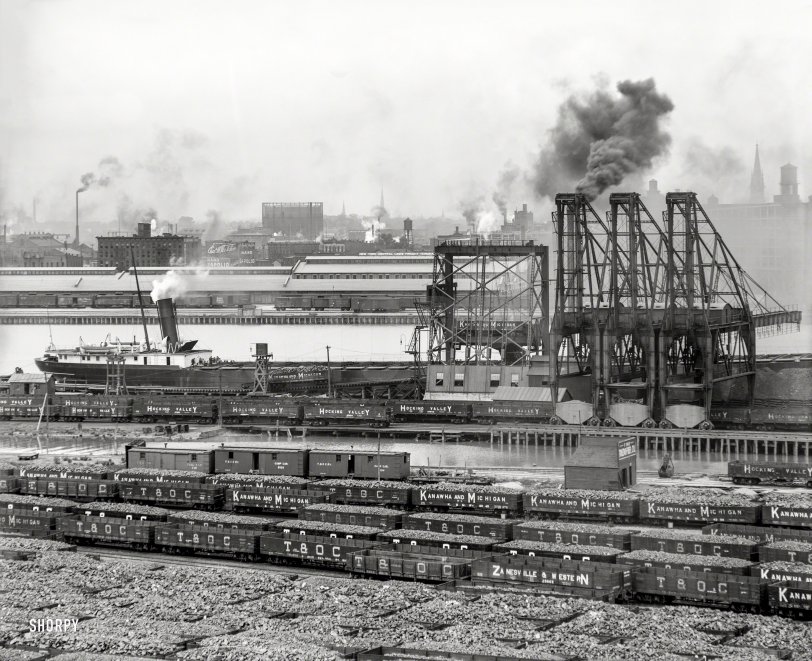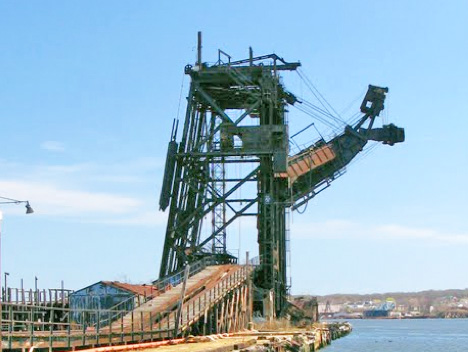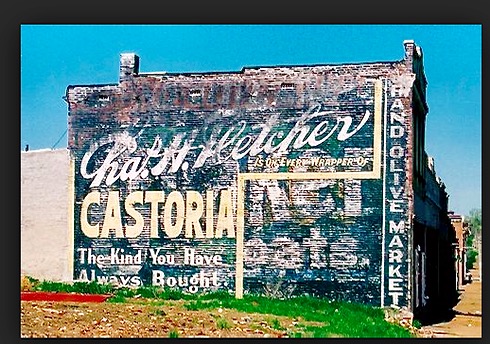


Framed or unframed, desk size to sofa size, printed by us in Arizona and Alabama since 2007. Explore now.
Shorpy is funded by you. Patreon contributors get an ad-free experience.
Learn more.

- Roll your own
- Rugged and real!
- A Charles Purcell - Mama Cass Connection
- Uncle SAAM
- Obfuscation
- One Chocolate Soldier rode away
- Victor Marquis de la Roche
- The Little House Across Way ...
- Vanderbilt Gates
- Vanderbilt Mansion
- You can still see that gate
- Withering heights for me
- So Jim,
- Top Heavy
- Re: Can't Place It.
- Bus ID
- Since you mention it
- The White Pages ?
- Moonlight Tower
- 1907?
- Fire(men) and Water
- Can't Place It
- Can anyone
- Wings
- Where's Claudette and Clark?
- Overbuilt Rolodex
- One song
- Give Me Wings Please!
- PRR
- Pinball Wizards
Printporium
Smokestack Industry: 1910

Circa 1910. "Maumee River waterfront -- Toledo, O." Railroads represented on the coal cars: Hocking Valley, Kanawha and Michigan, Zanesville & Western, Toledo & Ohio Central. 8x10 inch dry plate glass negative. View full size.
A snapshot of C&O history
This photo captures a point in Chesapeake & Ohio history where all of these roads were to some extent or another under its control. In this year the Hocking Valley got merged into the C&O; the other lines got merged together and and eventually ended up as part of the New York Central due to antitrust concerns. Of course much later in the Young period the NYC and C&O were closely allied, which was more or less made permanent when CSX and NS split up Conrail.
A current view
Here is the McMyler in New Jersey. It is an interesting "contraption."

Dr Fletcher, I Presume
In the background of this picture there is a wall with an ad for Chas H Fletcher"s Castoria, a nostrum ready to cure some of the ills of the 19th, 20th and even the beginning of the 21st Centuries. There were many walls near the Brooklyn Bridge decorated with the Castoria signage painted just in time for span's opening in 1883. The last of the signs that I know of were taken down in NYC about 2005. A better view is attached.

Model in operation
Here is a working model of a coal unloader. The empty car return is clearly seen. The model does not use the 'Barney' but rather a regular engine.
That belching smokestack
The densest plume of smoke is coming from a slender steel stack on a powerhouse between the McMyler coal unloader and the three gantry cranes. The RR car elevator on a McMyler coal dumper is powered by a reciprocating steam engine. This is no doubt the McMyler's boiler house.
Hocking Valley coal is bituminous coal, which can produce volumes of visible smoke.
There are many interesting details in this image, including a clamshell bucket resting on the near pier close to the combined office and scale house of the Toledo Fuel Co.
The presence of the Toledo & Ohio Central work train consisting of a tool car, two camp cars, and a flat car with a rest for the boom of a small RR maintenance crane might explain the presence of the clamshell bucket.
All-in-all, a "delicious" image of a time of great industries which were unfortunately accompanied by great pollution!
McMyler coal dumper
The leftmost pier-side structure is a McMyler coal unloader. This runs a RR car up a huge elevator and then bodily tips the whole car into an adjustable chute which carries the coal into a ship's hold. In the photo, a Kanawha & Michigan car is on the lift.
The loaded cars were pushed up the ramp and onto the elevator not by a locomotive but rather by a pushing device called a "Barney" that travelled between the running rails.
The track which slopes down to the left of the dumper, and then ascends again on the left edge of the frame is the very interesting empty car return of the McMyler system.
After the elevator brings the now-empty car back down, the car is "kicked" to the left and rolls down the slope, gaining momentum. The car then rolls uphill to a dead stop out of the photo, whereupon it starts rolling in the other direction. Right before the dead end is a spring-loaded track switch which diverts the rolling car toward the empty car storage yard.
There is one of these dumpers standing abandoned in Port Reading NJ on the Arthur Kill. It has not been used since 1980. The return track structure has suffered severe fire damage.
I know a man whose father was employed by the Reading RR to ride the coasting empty cars coming from the McMyler unloader. His function was to apply the hand brakes when they were about to couple to the string of empty cars in the collection yard. Think of what it would be like to do this at night in a snowstorm!
























On Shorpy:
Today’s Top 5